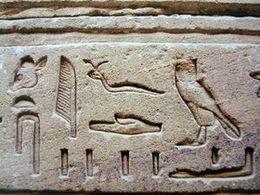A hieroglyph (Greek for "sacred carvings") was a character of the ancient Egyptian writing system. Logographic scripts that are pictographic in form in a way reminiscent of ancient Egyptian are also sometimes called "hieroglyphs".[1] In Neoplatonism, especially during the Renaissance, a "hieroglyph" was an artistic representation of an esoteric idea, which Neoplatonists believed actual Egyptian hieroglyphs to be. The word hieroglyphics refers to a hieroglyphic script.
The Egyptians invented the pictorial script. The appearance of these distinctive figures in 3000 BCE marked the beginning of Egyptian civilization. Though based on images, Egyptian script was more than a sophisticated form of picture-writing. Each picture/glyph served one of three functions: (1) to represent the image of a thing or action, (2) to stand for a sound or the sounds of one to as many as three syllables, or (3) to clarify the precise meaning of adjoining glyphs. Writing hieroglyphs required some artistic skill, limiting the number chosen to learn it.[2] Only those privileged with an extensive education (i.e. the Pharaoh, nobility and priests) were able to read and write hieroglyphs; others used simpler 'joined-up' versions: demotic and hieratic script.
List of scripts and script-like systems sometimes labeled 'hieroglyphic'
- Anatolian hieroglyphs
- Aztec hieroglyphs
- Chinese characters
- Cretan hieroglyphs
- Egyptian hieroglyphs
- Mayan hieroglyphs
- Mi'kmaq hieroglyphs
- Muisca hieroglyphs
- Ojibwe hieroglyphs
- Olmec hieroglyphs
One of the two forms of the Meroitic writing system is usually described as "Meroitic hieroglyphs" because the characters are similar to and in most cases derived from Egyptian hieroglyphs. They are used, however, not as logographs but as an alphasyllabary.
In Eastern Slavic languages, the term hieroglyph refers to any morphemic script, and is commonly synonymous to Chinese and Japanese writing.
See also
References
- ^ "Egypt, Ancient: Hieroglyphics and Origins of Alphabet". Encyclopedia of African History Title information – via Credo Reference (subscription required). Retrieved 12 September 2012.
- ^ The Alphabet Versus the Goddess, by Leonard Shlain
Further reading
- Allen, James P. (2001). Middle Egyptian: An Introduction to the Language and Culture of Hieroglyphs. New York: Cambridge University Press. ISBN 9780521774833. OCLC 51226851.
- Brewer, Douglas J.; Teeter, Emily (2007). Egypt and the Egyptians. Cambridge: Cambridge University Press. ISBN 9780521851503. OCLC 433993212.
- Kamrin, Janice (2004). Ancient Egyptian Hieroglyphs: A Practical Guide. New York: Harry N. Abrams. ISBN 9780810949614. OCLC 55019226.
- Robinson, Andrew (2007). The Story of Writing: Alphabets, Hieroglyphs & Pictograms. London: Thames & Hudson. ISBN 978-050028660-9. OCLC 172818065.
